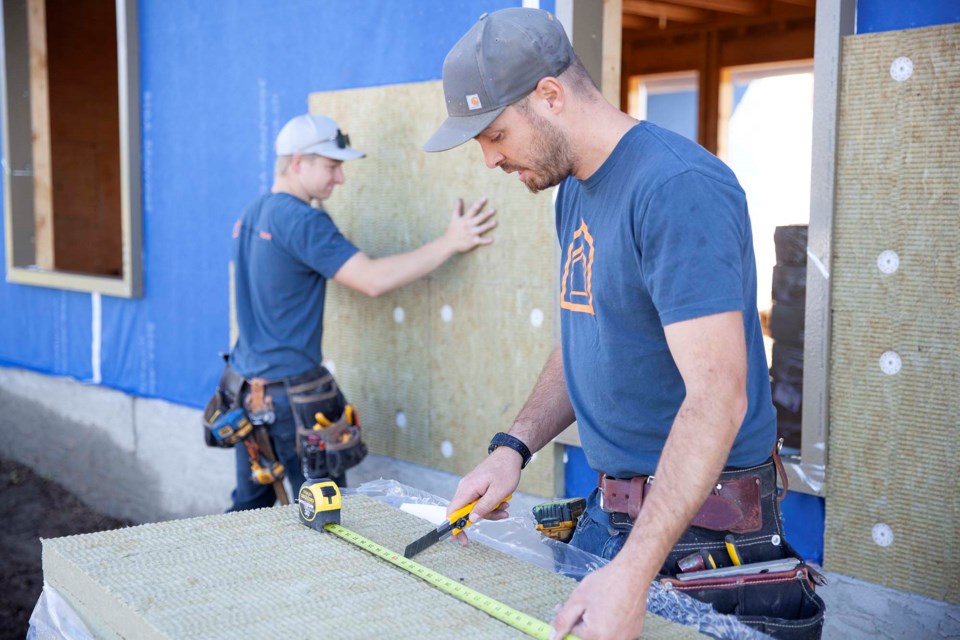This Green House
The Gazette is taking a close look at green retrofits you can fund with CEIP grants. Got a question about retrofits? Email them to [email protected]
There's a souped-up truck that lurks outside my window. Because my walls have such poor insulation, I can hear every decibel of its shrieking, howling, monstrously loud motor when it roars to life every night.
It’s times like those that I think back to Mehmet Yigit’s net-zero home in Sturgeon County, which I visited in 2018. Its walls were so thick and insulated that it was cozy and quiet year-round, despite being mere metres away from the roar of Highway 2.
“The people should go for this because it’s very comfortable living,” Yigit told me at the time of building net-zero.
Seal first, insulate next
Insulation is the second thing you should add to a house if you want to renovate it to net-zero, said Jamie Van Gelderen, president of Performance Haus Inc. (which provides super-efficient products for net-zero homes around Edmonton).
The first is air-sealing, which we covered in last week’s This Green House column.
“You can add insulation onto an existing building, but if you’re not controlling air tightness, that insulation has less of an effect,” Van Gelderen said.
Insulation can also cause more problems without proper air-sealing, he continued. Without a proper air barrier in place for your attic, for example, adding insulation can trap moisture that drips down as drywall-damaging “attic rain.”
If air leaks account for about 30 per cent of a home’s heat loss, poor insulation makes up the rest, said Godo Stoyke of Carbon Busters. A typical Alberta home will have R5 insulation in the basement, R20 in the walls, and R40 in the roof. (R-values are a measure of insulation value. Higher numbers are better.) A net-zero home will have an R30 basement, R45 walls, and R60 in the roof.
Where, what, how much
The easiest and cheapest place to add insulation to your home is the hot water pipe attached to your water heater, Stoyke said. Slap an insulated sleeve on it, which costs pennies per foot, and you can make your money back in a matter of months.
“For $3 you can save about $17 a year,” Stoyke said, or about $300 over the life of the water heater.
The next easiest spot is your attic. Most people can get an attic to R60 with less than $900 of blow-in insulation, Stoyke said. To figure out how much insulation to add, use a ruler and this rule of thumb: an inch of cellulose insulation has an R-value of about 3.6. An R60 attic should have about 17 inches of cellulose in it.
While you can use spray-foam insulation instead of cellulose, Stoyke recommends saving it for hard-to-reach places like rim joists, as it is expensive compared to cellulose. Spray foam can also help with air-tightness.
Re-insulating a wall can cost tens of thousands of dollars, so save it for when you already have to rip the walls open to redo siding or replace windows, Van Gelderen said.
Van Gelderen recommended applying wall insulation to the outside of your walls rather than the inside. Doing so preserves the integrity of your home’s vapour barrier and also eliminates thermal bridging, which is where the studs in your walls conduct heat from your room to the outside, bypassing the insulation in between the studs. (See the dark bars on the walls of The Gazette building in St. Albert on a cold day, for example.)
“You want to wrap your house in a nice sweater,” Van Gelderen said.
Van Gelderen recommends either mineral wool or expanded polystyrene panels for exterior wall insulation, as they will not trap moisture.
For your basement, insulate the outside of the foundation if it’s exposed to the open air, Stoyke said. Anything below ground isn’t as important, as the earth itself serves as partial insulation. Still, an inch or so of expanded polystyrene down there will make the basement much more comfortable.
Adding insulation, especially to your walls, can cost tens of thousands of dollars. Homeowners can tap into St. Albert's CEIP initiative to cover these costs. The federal Greener Homes program offers up to $5,000 in grants and $40,000 in interest-free loans for major insulation projects.
Better insulation makes for a warmer winter home and a cooler summer one. Most insulation pays for itself in about 10 years, Van Gelderen said.
Stapling some insulation to my walls would cut down on the noise from that truck. Then again, so would insulating the truck.
Green Actions
(Information from Godo Stoyke)
Action: insulate hot water pipe
Cost: about $3
Payback: less than a year
Savings: $17 and about 10 kg after a year
Greener Homes rebates: none for this; up to $5,000 for bigger projects
CEIP eligible: not for this; yes for bigger projects



